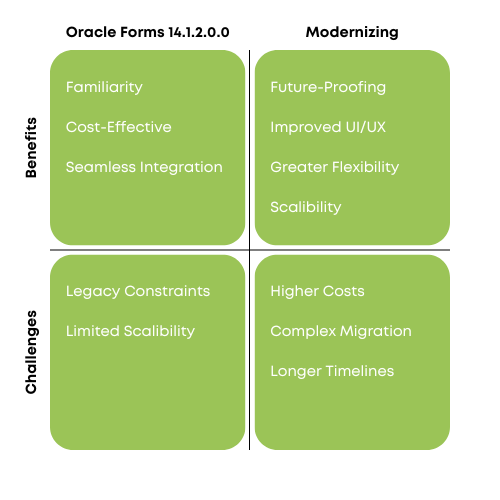
Oracle Forms 14.1.2.0.0 marks a significant update in the Oracle Fusion Middleware ecosystem, bringing a host of new features and enhancements aimed at improving usability, integration, and performance. In this article, we’ll explore the key updates and discuss whether upgrading to this latest version or Oracle Forms modernization to a newer technology is the best path forward for your organization.
Key Features in Oracle Forms 14.1.2.0.0
Runtime Improvements and New Features
- User Interface Enhancements:
- New properties for widgets to improve application appearance and behavior.
- Features like prompt-like text in text fields, progress bars, auto-complete combo boxes, and more.
- REST Service Integration:
- CRUD operations on REST services via PL/SQL, enhancing flexibility beyond Oracle Database.
- Continuous Query Notification (CQN):
- Simplified integration with Oracle Database’s CQN for object and query result change notifications.
- Block Sorting:
- New SORT_BLOCK built-in for sorting data blocks locally without re-querying the database.
- Glass Fill Pattern:
- Transparent UI objects for dynamic and visually appealing designs.
- Auto-Size Blocks:
- Blocks dynamically adjust visible rows based on query results, improving layout efficiency.
- 2FA for Java Web Start:
- Two-factor authentication support for enhanced security.
- Automatic JNLP Deletion:
- Improved disk space usage and security by auto-deleting JNLP files after use.
Form Builder Improvements
- REST Package Designer:
- Simplified creation of PL/SQL units for REST service integration.
- Multi-Select Open File Dialog:
- Improved developer efficiency with multi-file selection.
- Database Connect Name Display:
- Quick reference to database connection aliases.
- XML Generation on Save:
- Automatic creation of XML versions of modules for better source control.
- Support for Long Table and Column Names:
- Expanded support for names up to 128 bytes.
Administration and Installation Enhancements
- Enhanced Configuration Editing:
- Full-text editor for Forms configuration files in Fusion Middleware Control.
- Bulk RAD Uploading:
- Simplified setup with batch Remote Access Descriptor uploads.
- Lightweight Domain Template:
- New template for developers that reduces installation complexity.
While these updates may sound appealing, the question remains: Is upgrading enough, or is it time to move on from Oracle Forms altogether?
The Limitations of Oracle Forms
Despite these somewhat recent improvements, Oracle Forms remains, at its core, a legacy system. Originally designed for client-server environments, it struggles to keep pace with modern development standards like microservices, cloud-native architectures, and web-based interfaces.
Here are a few reasons why continuing to rely on Oracle Forms might be holding your business back:
- Lack of Flexibility: Oracle Forms operates within a tightly defined structure, which limits its ability to integrate with newer technologies such as cloud services and RESTful APIs.
- High Maintenance Costs: Maintaining a legacy system requires specialized skills and knowledge that are increasingly hard to find as younger developers are trained on modern languages like Java, .NET, and Python. This can lead to higher operational costs over time.
- Performance Issues: Oracle Forms was built for an era when applications were relatively simple. Modern applications often require a level of scalability and performance optimization that Oracle Forms struggles to deliver, particularly for web and mobile interfaces.
- Vendor Lock-in: As Oracle continues to push cloud-based services and subscription models, businesses relying on Oracle Forms may find themselves increasingly locked into the Oracle ecosystem, limiting their ability to adopt more flexible, cost-effective solutions.
Upgrade vs. Modernization: Which Path to Choose?
Organizations running Oracle Forms face a crucial decision: upgrade to the latest version or modernize by migrating to newer technologies. Here’s a breakdown of the pros and cons of each approach:
Upgrading to Oracle Forms 14.1.2.0.0

Benefits:
- Familiarity: Minimal disruption as the core framework remains consistent.
- Cost-Effective: Lower initial investment compared to full modernization.
- Seamless Integration: Leverage existing Oracle Database and middleware infrastructure.
Challenges:
- Legacy Constraints: Continued reliance on older paradigms and technology stacks.
- Limited Scalability: Modern cloud-native applications may offer better long-term scalability.
Why Modernize Now?
Modernizing Oracle Forms to a more adaptable, scalable system like Java, .NET, or cloud-native platforms offers businesses a strategic edge in today’s fast-evolving technological landscape. While the new Oracle Forms 14.1.2.0.0 release brings valuable updates, it still operates within the constraints of legacy technology. By modernizing, your organization can unlock new opportunities for innovation, growth, and operational efficiency.
Here’s why now is the ideal time to modernize:
- Future-Proofing: Transitioning to modern platforms ensures your business is prepared to leverage emerging technologies such as cloud computing, AI, and advanced analytics—capabilities that Oracle Forms cannot fully support.
- Enhanced Scalability: Modern architectures are designed to scale effortlessly with growing workloads, enabling your applications to adapt to increasing user demands and business expansion.
- Cost Optimization: Maintaining legacy systems often incurs rising costs over time. Modernized systems offer lower maintenance overheads, better resource utilization, and long-term cost savings.
- Improved User Experience: Modern platforms provide advanced UX/UI capabilities, delivering intuitive, responsive, and user-friendly applications for both internal teams and customers.
- Access to Talent: Moving to widely adopted technologies like Java or .NET makes it easier to attract and retain skilled professionals, avoiding the challenges of finding Oracle Forms specialists.
How Morphis Tech Can Help
At Morphis Tech, we excel in transforming legacy Oracle Forms systems into cutting-edge, scalable architectures using automated modernization tools. Our proven methodology minimizes risk, reduces downtime, and accelerates the migration process, ensuring a seamless transition to technologies like Java, .NET, or cloud-native platforms.
Our modernization solutions go beyond simple code conversion. We provide:
- Automation-Driven Transformation: Our tools automate much of the modernization process, reducing errors and ensuring consistency.
- Preservation of Business Logic: We safeguard the core logic and functionality of your existing systems while modernizing their architecture.
- Minimal Disruption: Our approach is designed to minimize downtime and maintain business continuity throughout the migration process.
- Enhanced Scalability: The new platform will support growth, enabling your business to handle future demands effortlessly.
While Oracle Forms 14.1.2.0.0 provides incremental improvements, it cannot match the long-term benefits of modernization. If your organization is still relying on Oracle Forms, now is the time to partner with Morphis Tech and future-proof your operations with a modern, flexible, and scalable system.
Conclusion
Oracle Forms 14.1.2.0.0 offers compelling new features that enhance performance, usability, and integration capabilities. For organizations deeply embedded in the Oracle ecosystem, upgrading is a straightforward path to leverage these improvements while maintaining operational continuity. However, for those seeking to innovate and future-proof their applications, modernization to newer technologies may be the better long-term strategy.
Carefully evaluate your organization’s needs, budget, and strategic goals to determine the best course of action. Whether you choose to upgrade or modernize, the decision should align with your vision for scalability, user experience, and technological relevance.
Learn more about our Oracle Forms modernization here.


Leave a Reply